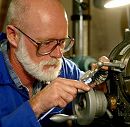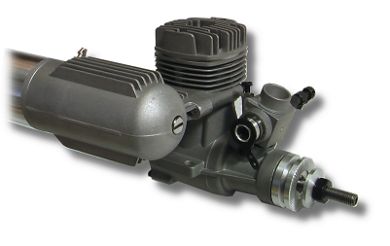Your Reviewer
My Credentials
So who's doing this reviewing then?

Well I've been building and flying or driving radio controlled models for over 40 years and during that time I like to think I've built up a reasonable amount of knowledge.
I'm also a qualified electronics engineer who has worked in radio frequency, analog, digital systems and software for more than three decades. In fact I designed and built my first RC set back in 1969.
For the past nine years I've also been involved in the design and manufacture of some rather sophisticated engine technology and UAV flight control systems.
So, chances are I've been there, done that and have a huge pile of tee shirts to prove it.
Right now I'm heavily into 3D flying and enjoy all aspects of the RC hobby. I may be old but I don't feel it.
In the Pipeline
Here's just a little bit of what's to come on this site...
RC explained: Demystifying terms such as PCM, PPM dual conversion, single conversion, full-range etc., this feature will explain it all.
Cheap Chinese Engines: Just how good are those cheap Chinese glow and gas engines that sell for half the price of their "brand-name" equivalent? I put several to the test.
Build your own radio gear?: Back in the old days, building your own RC gear was not uncommon and now the arrival of 2.4GHz has made it practical again.
Review: ASP52 glow/nitro engine
A POWERHOUSE 40-CLASS ENGINE

Dated: 20 May 2010
There was a time when the only engines anyone would really consider for their .40-class glow-powered models was an OS.
There were a long line of popular and reliable OS engines including the FP series, the FSR, the SF and so on.
There was a bit of a hiccup when the OS46FX first appeared, with many engines suffering from peeled liners and a lot of unhappy customers swearing never to buy another OS engine as a result -- but today's OS engines are as reliable and powerful as ever.
But this isn't a review of an OS engine, it's a review of the current .52 cubic inch (8.5cc) 2-stroke engine from Sanye.
A lot of people reading this review will never have heard of Sanye, but chances are you've seen their products many times before. The engines made by Sanye are sold under a growing number of names, including ASP, Magnum, Super Custom and others.
The engine I'm reviewing here is the ASP.52 2-stroke but, for all intents and purposes, it's the same as the Magnum.52.
First Look
The test engine was purchased from Hobby King and cost little more than $50 which is an absolute steal when compared to the price that you'll pay for an OS or even a Thunder Tiger .40-class ball-raced engine these days.

Like most other brands, it comes in a cardboard box containing plenty of padding and various parts of the engine (muffler, carburetor, engine) in separate bags.
Although an instruction sheet is supplied, it makes no mention of how to assemble these parts, which is a shame because there are some traps novices that really ought to be covered (I'll tell you about those later).
The instruction sheet that is included is a generic one that seems to be designed to cover the entire range of Sanye engines, right from their 1cc 2-stroke through to the monster 64cc 5-cylinder radial.
For a Chinese-made document it contains pretty good English, although I noted with a grin this extract: "NEVER ALTER, REPAIR, BENO, OR SHAVE A PROPELLER." How on earth do you BENO a propeller I wonder?
Design and quality of construction

Like most modern glowplug engines, the ASP has nicely finished pressure die-castings which show no signs of porosity or other flaws. Likewise, the machining appears to be done to a high standard and finish.
The crankcase, cylinder head, backplate, carburetor body and two parts of the muffler are all cast from aluminum.
The cylinder sleeve is chrome-plated brass, meaning this is a true ABC engine, a design choice that is technically superior to the nickel-over-brass used by OS, Thunder Tiger and some other manufacturers. Because of the overbored nature of this engine, the liner itself is quite thin, which leaves little potential for quick hop-ups by way of some port-grinding. However, as you'll see, it's more than powerful enough without the need for such modifications.
The crankshaft is steel with the usual diameter (for a .40-class engine) and appears to be well made. It is supported on two industry-standard sized bearings (6902 and R8) but the bearings provided seem to be of relatively low quality. I find it strange that these days, even "quality" brands such as Saito and OS tend to skimp on the quality of bearings used in their engines -- ASP is not alone in their cost-cutting here.
The connecting rod is machined aluminum with a phosphor-bronze bushing on the crankpin journal. I don't know if the wrist-pin is also bushed, it didn't seem worth dismantling the engine to that extent to find out. I've never heard of any modern 2-stroke engines suffering wrist-pin failure and this is (after all) just a $50 engine.
The carburetor is the biggest disappointment of this engine. It is a two-needle type with the conventional rotating barrel and auto-mixture control. However, the main needlevalve is a very sloppy fit and despite having two O-rings to try and maintain a good seal, it is prone to air-leaks. What's more, the small spring-loaded arm designed to stop the needle from rotating with vibration is not always strong enough.
The carburetor is attached to the engine by way of two cap-head screws that are threaded into the carb spigot. Personally I dislike this method of carb attachment as it is also prone to allowing air-leaks and requires *very* careful tightening of the retaining bolts. Too loose and they'll vibrate right out. Too tight and the threads in the cast aluminum carby will strip -- whereupon the bolts will still fall out. Two tiny spring washers are provided to assist -- but, given the lack of suitable instructions, I fear that some owners will mistakenly use these on the muffler bolts instead.
I really recommend a little blue (low-strength) thread-locker on the carby retaining bolts and a "gentle but firm" hand when tightening them.
Related links
Fresh Articles:
Join the Forums!
The Blog
Updated: 20 Sep 2012
Here's a blog that will keep you informed just what's going on behind
the scenes at RC Model Reviews and also tells you a little more about
myself.
How compatible are 2.4GHz RC systems?
23 Mar 2010
How come there's no compatibility between different brands of transmitters and receivers?
Why can't you use a cheap Chinese receiver with your Futaba FASST radio?
How to get a product reviewed here
4 Mar 2010
Since this has become a very frequently asked question, I've posted this
simple guide to getting your product, or a product you're thinking of
buying reviewed here at RCModelReviews
How servos work
Useful information on what's inside your servos and how they work.
The Good Oil
Important facts you should know about the oils that are used in our model engine fuels.
Heads-Up: 2.4GHz RC systems tested
How well do five different 2.4GHz systems stack up when hit by interference? The answers are here, with more to come.
Review: Bushnell's $80 Speed Gun
Yes it does work on model airplanes but there are some limitations involved with this bargain-basement radar speed gun.
Review: TowerPro MG995 servo
These are possibly the world's worst servos, find out exactly why you should avoid these boat-anchors at any cost.
Review: SK90

It's cheap but can it really stack up against other glow engines in the .90 market? Find out in this review.
Review: iMax 9X 2.4GHz radio
How does this cheap 9-channel 2.4GHz radio system perform when compared to big-name systems that can cost two or three times as much? Have the Chinese finally developed a real contender with the iMax 9X?
2.4GHz Explained
Does all this 2.4GHz stuff have your head spinning?

I've done my best to demystify the whole subject so if you feel like a bit of learning, this is the stuff for you!
Fix That Engine!
How can you tell when your engine needs new bearings? Who has the best prices and service on replacements? Just how do you change them? Get all that information and watch a great video tutorial anyone can follow.
Chinese Servos - How do they stack up?

The Chinese are now churning out a huge number of very reasonably priced no-name servos. But are they any good?
Baffled by batteries?
 Nicad, NiMH, Li-Ion, LiPoly, LiFePO4, A123... the range of different
battery types has never been greater. So how do they differ and
what type should you be using?
Nicad, NiMH, Li-Ion, LiPoly, LiFePO4, A123... the range of different
battery types has never been greater. So how do they differ and
what type should you be using?
Possibly useful:
